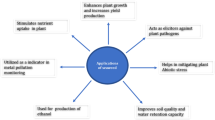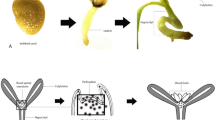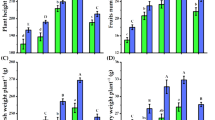Abstract
In vitro shoot cultures of ragweed (Ambrosia artemisiifolia L.), an important weed and allergen species, were established and utilized to explore the phytotoxic effect of essential oils of Nepeta rtanjensis Diklić and Milojević, and N. cataria L. Ragweed shoots were exposed to the atmosphere enriched with volatile compounds emitted from essential oils which differ in their qualitative and quantitative nepetalactone content. Essential oil of N. rtanjensis, an endemic and critically endangered perennial in Serbia, was characterized by high amounts of 4aα,7α,7aβ-nepetalactone (trans,cis-nepetalactone), while essential oil of N. cataria, possessed high amounts of 4aα,7α,7aα-nepetalactone (cis,trans-nepetalactone). After 2 weeks of exposure to Nepeta essential oil (2 and 4 %, final nepetalactone concentrations), in vitro morphogenesis of ragweed shoots was significantly altered. Reduction in fresh weight of shoots and roots and rooting inhibition was observed together with prominent discoloration of shoots. Alterations in antioxidative defense system of ragweed shoots as a response to essential oils treatments were characterized by increased peroxidase activity and decreased catalase and superoxide dismutase activity. Generally, essential oil of N. cataria, which possesses cis,trans-stereoisomer of nepetalactone, had stronger inhibitory effect on shoot growth, catalase activity, and was more efficient in stimulating peroxidase activity. N. rtanjensis essential oil, and thus trans,cis-nepetalactone, was more efficient in inhibiting rooting and root growth, and in suppressing superoxide dismutase activity. Therefore, essential oils of N. rtanjensis and N. cataria might find another application as potential bioherbicides against highly invasive species such as ragweed.





Similar content being viewed by others
Abbreviations
- BM:
-
Basal medium
- BSA:
-
Bovine serum albumin
- CAT:
-
Catalase
- DTT:
-
Dithiothreitol
- EDTA:
-
Ethylenediaminetetraacetic acid
- EO:
-
Essential oil
- GC–FID:
-
Gas chromatography with flame ionization detector
- GC–MS:
-
Gas chromatography with mass spectrometry
- NBT:
-
Nitro blue tetrazolium chloride
- NFDM:
-
Non-fat dry milk
- PAGE:
-
Polyacrylamide gel electrophoresis
- PBS:
-
Phosphate-buffered saline
- PMSF:
-
Phenylmethanesulfonyl fluoride
- POX:
-
Peroxidase
- PVPP:
-
Polyvinylpolypyrrolidone
- ROS:
-
Reactive oxygen species
- SB:
-
Sample buffer
- SDS:
-
Sodium dodecyl sulfate
- SOD:
-
Superoxide dismutase
- TEMED:
-
Tetramethylethylenediamine
- TPBS:
-
Tween (0.05 %) in PBS buffer
- VOC:
-
Volatile compound
References
Adams RP (2007) Identification of essential oil components by gas chromatography/mass spectrometry. Allured Publishing Corporation, Illinois
Aebi H (1984) Catalase in vitro. Meth Enzymol 105:121–126
Akin-Idowu PE, Ibitoye DO, Ademoyegun OT (2009) Tissue culture as a plant production technique for horticultural crops. Afr J Biotechnol 8(16):3782–3788
Araniti F, Graña E, Reigosa MJ, Sánchez-Moreiras AM, Abenavoli MR (2013) Individual and joint activity of terpenoids, isolated from Calamintha nepeta extract, on Arabidopsis thaliana. Nat Prod Res 27(24):2297–2303
Bates RB, Sigel CW (1963) Terpenoids, cis-trans and trans-cis nepetalactones. Experientia 19:564–565
Beauchamp C, Fridovich I (1971) Superoxide dismutase: improved assays and an assay applicable to acrylamide gels. Anal Biochem 44:276–287
Beyer WF Jr, Fridovich I (1987) Assaying for superoxide dismutase activity: some large consequences of minor changes in conditions. Anal Biochem 161(2):559–566
Bhagwath SG, Hjortsø MA (2000) Statistical analysis of elicitation strategies for thiarubrine A production in hairy root cultures of Ambrosia artemisiifolia. J Biotechnol 80:159–167
Birkett MA, Pickett JA (2003) Aphid sex pheromones: from discovery to commercial production. Phytochemistry 62(5):651–656
Birkett MA, Hassanali A, Hoglund S, Pettersson J, Pickett JA (2011) Repellent activity of catmint, Nepeta cataria, and iridoid nepetalactone isomers against Afro-tropical mosquitoes, ixodid ticks and red poultry mites. Phytochemistry 72:109–114
Bradford MM (1976) A rapid and sensitive method for the quantitation of microgram quantities of protein utilizing the principle of protein-dye binding. Anal Biochem 72(1):248–254
Chalchat JC, Gorunović MS, Petrović SD, Maksimović ZA (2000) Composition of the essential oils of Nepeta rtanjensis Diklić and Milojević, Lamiaceae from Serbia. J Essent Oil Res 12:238–240
Chowhan N, Singh HP, Batish DR, Kohli RK (2011) Phytotoxic effects of β-pinene on early growth and associated biochemical changes in rice. Acta Physiol Plant 33:2369–2376
Chowhan N, Singh HP, Batish DR, Kaur S, Ahuja N, Kohli RK (2013) β-Pinene inhibited germination and early growth involves membrane peroxidation. Protoplasma 250:691–700
Dayan FE, Cantrell CL, Duke SO (2009) Natural products in crop protection. Bioor Med Chem 17(12):4022–4034
Dhindsa RA, Plumb-Dhindsa P, Thorpe TA (1981) Leaf senescence correlated with increased permeability and lipid peroxidation, and decreased levels of superoxide dismutase and catalase. J Exp Bot 126:93–101
Ding J, Sun Y, Xiao CL, Shi K, Zhou YH, Yu JQ (2007) Physiological basis of different allelopathic reactions of cucumber and figleaf gourd plants to cinnamic acid. J Exp Bot 58(13):3765–3773
Duke SO (2010) Allelopathy: current status of research and the future of the discipline: a commentary. Allelopathy J 25(1):17–30
Gkinis G, Tzakou O, Iliopoulou D, Roussis V (2003) Chemical composition and biological activity of Nepeta parnassica oil and isolated Nepeta lactons. Natur forsch 58:681–686
Gomez-Barrious ML, Parodi FJ, Vargas D, Quijano L, Hjortso MA, Flores AE, Fischer NH (1992) Studies on the biosynthesis of thiarubrine A in hairy root cultures of Ambrosiaartemisiifolia using 13C-labelled acetates. Phytochemistry 31:2703–2707
Grayson BT, Williams KS, Freehauf PA, Pease RR, Ziesel WT, Sereno RL, Reinsfelder RE (1987) The physical and chemical properties of the herbicide cinmethylin. Pestic Sci 21(2):143–153
Gyoffry B, Hunyadi K, Kadar A, Molnar J, Toth A (1995) Hungarian national weed surveys 1950–1992. EWRS Symposium (9th) Budapest 1–11
Hong Y, Hu H-Y, Xiea Li F-M (2008) Responses of enzymatic antioxidants and non-enzymatic antioxidants in the cyanobacterium Microcystis aeruginosa to the allelochemical ethyl 2 methyl acetoacetate (EMA) isolated from reed (Phragmites communis). J Plant Physiol 165:1264–1273
Hyun Eom S, Yang HS, Weston LA (2006) An evaluation of the allelopathic potential of selected perennial groundcovers: foliar volatiles of catmint (Nepeta faassenii) inhibit seedling growth. J Chem Ecol 32(8):1835–1848
Kalpoutzakis E, Aligiannis N, Mentis A, Mitaku S, Charvala C (2001) Composition of the essential oil of two Nepeta species and in vitro evaluation of their activity against Helicobacter pylori. Planta Med 67:880–883
Kobaisy M, Tellez MR, Dayan FE, Mamonov LK, Mukanova GS, Sitpaeva GT, Gemejieva NG (2005) Composition and phytotoxic activity of Nepeta pannonica L. essential oil. J Essent Oil Res 17(6):704–707
Laemmli UK (1970) Cleavage of structural proteins during the assembly of the head of bacteriophage T4 680. Nature 227:680–685
Li ZH, Wang Q, Ruan X, Pan CD, Jiang DA (2010) Phenolics and plant allelopathy. Molecules 15:8933–8952
Lindinger W, Hansel A, Jordan A (1998) On-line monitoring of volatile organic compounds at pptv levels by means of proton-transfer-reaction mass spectrometry (PTR-MS) medical applications, food control and environmental research. Int J Mass Spectrom 173(3):191–241
Ljaljević Grbić M, Stupar M, Vukojević J, Soković M, Mišić D, Grubišić D, Ristić M (2008) Antifungal activity of Nepeta rtanjensis essential oil. J Serb Chem Soc 3(10):961–965
Mancini E, Apostolides AN, Feo V, Formisano C, Rigano D, Piozzi F, Senatore F (2009) Phytotoxic effects of essential oils of Nepeta curviflora Boiss. and Nepeta nuda L. subsp. albiflora growing wild in Lebanon. J Plant Inter 4(4):253–259
Michalski WP (1996) Chromatographic and electrophoretic methods for analysis of superoxide dismutases. J Chromatogr B 684:59–75
Mišić D, Šiler B, Gašić U, Avramov S, Živković S, Nestorović Živković J, Milutinović M, Tešić Ž (2014) Simultaneous UHPLC/DAD/(+/)HESI–MS/MS analysis of phenolic acids and nepetalactones in methanol extracts of Nepeta species: a possible application in chemotaxonomic studies. Phytochem Anal. doi:10.1002/pca.2538
Murashige T, Skoog F (1962) A revised medium for rapid growth and bio assays with tobacco tissue cultures. Physiol Plant 15(3):473–497
Mutlu S, Atici O, Esim N, Mete E (2011) Essential oils of catmint (Nepeta meyeri Benth.) induce oxidative stress in early seedlings of various weed species. Acta Physiol Plant 33:943–951
Nestorović Živković J (2013) Antioxidative, antimicrobial and allelopathic effects of three endemic Nepeta species (Lamiaceae). Dissertation, University of Belgrade
Nestorović J, Mišić D, Šiler B, Soković M, Glamočlija J, Ćirić A, Maksimović V, Grubišić D (2010) Nepetalactone content in shoot cultures of three endemic Nepeta species and the evaluation of their antimicrobial activity. Fitoterapia 81(6):621–626
Nishida N, Tamotsu S, Nagata N, Saito C, Sakai A (2005) Allelopathic effects of volatile monoterpenoids produced by Salvia leucophylla inhibition of cell proliferation and DNA synthesis in the root apical meristem of Brassica campestris seedlings. J Chem Ecol 31(5):1187–1203
Noctor G, Foyer CH (1998) Ascorbate and glutathione: keeping active oxygen under control. Annu Rev Plant Physiol Plant Mol Biol 49:249–279
Oleszek W, Stochmal A (2002) Triterpene saponins and flavonoids in the seeds of Trifolium species. Phytochemistry 61(2):165–170
Peterson C, Coats J (2001) Insect repellents—past, present and future. Pestic Outlook 12:154–158
Peterson CJ, Nemetz LT, Jones LM, Coats JR (2002) Behavioral activity of catnip (Lamiaceae) essential oil components to the German cockroach (Blattodea:Blattellidae). J Econ Entomol 95:377–380
Romagni JG, Allen SN, Dayan FE (2000) Allelopathic effects of volatile cineoles on two weedy plant species. J Chem Ecol 26(1):303–313
Romero-Calvo I, Ocón B, Martínez-Moya P, Suárez MD, Zarzuelo A, Martínez-Augustin O, de Medina FS (2010) Reversible Ponceau staining as a loading control alternative to actin in Western blots. Anal Biochem 401(2):318–320
Rothe GM (2002) Enzyme assays after gel electrophoresis. In: Eisenthal R, Danson MJ (eds) Enzyme assays, a practical approach, 2nd edn. Oxford University Press, Oxford, p 198
Schulz M, Kussmann F, Knop M, Kriegs B, Gresens F, Eichert T, Ulbrich A, Marx F, Fabricius H, Goldbach H, Noga G (2007) Allelopathic monoterpenes interfere with Arabidopsis thaliana cuticular waxes and enhance transpiration. Plant Signal Behav 2(4):231–239
Singh HP, Batish DR, Kaur S, Ramezani H, Kohli RK (2002) Comparative phytotoxicity of four monoterpenes against Cassia occidentalis. Ann Appl Biol 141:111–116
Singh HP, Batish DR, Kohli RK (2004) Allelopathic effect of two volatile monoterpenes against bill goat weed (Ageratum conyzoides L.). Crop protection 21:347–350
Singh HP, Batish DR, Kaur S, Kohli RK, Arora K (2006a) Phytotoxicity of the volatile monoterpene citronellal against some weeds. Zeitschrift für Naturforschung C 61:334–340
Singh HP, Batish DR, Kaur S, Arora K, Kohli RK (2006b) α-pinene inhibits growth and induces oxidative stress in roots. Ann Bot 98:1261–1269
Singh HP, Kaur S, Mittal S, Batish DR, Kohli RK (2009) Essential oil of Artemisia scoparia inhibits plant growth by generating reactive oxygen species and causing oxidative damage. J Chem Ecol 35:154–162
Soltys D, Krasuska U, Bogatek R, Gniazdowska A (2013) Allelochemicals as Bioherbicides—Present and perspectives, In: Price A (ed) Herbicides—Current research and case studies in use, InTech, doi: 10.5772/56185. Available from: http://www.intechopen.com/books/herbicides-current-research-and-case-studies-in-use/allelochemicals-as-bioherbicides-present-and-perspectives
Stojanović G, Radulović N, Lazarević J, Miladinović D, Đoković D (2005) Antimicrobial activity of Nepeta rtanjensis essential oil. J Essent Oil Res 17:587–589
Taipale R, Ruuskanen TM, Rinne J, Kajos MK, Hakola H, Pohja T, Kulmala M (2008) Technical Note: quantitative long-term measurements of VOC concentrations by PTR-MS–measurement, calibration, and volume mixing ratio calculation methods. Atmos Chem Phys 8(22):6681–6698
Taramarcaz P, Lambelet C, Clot B, Keimer C, Hauser C (2005) Ragweed (Ambrosia) progression and its health risks: will Switzerland resist the invasion? Swiss Med Wkly 135:538–548
Thorpe T (2007) History of plant tissue culture. J Mol Microbiol Biotechnol 37:169–180
Woodbury W, Spencer AK, Stahmann MA (1971) An improved procedure using ferricyanide for detecting catalase isozymes. Anal Biochem 44:301–305
Acknowledgments
This study was supported by the Serbian Ministry of Education, Science and Technological development (grants No. OI173024 and III 41011). The authors would like to thank Dr. Michael Birkett (Biological Chemistry and Crop Protection Department, Rothamsted Research, Harpenden, Herts., Great Britain) for providing N. cataria EO.
Author information
Authors and Affiliations
Corresponding author
Additional information
Communicated by M. J. Reigosa.
Rights and permissions
About this article
Cite this article
Dmitrović, S., Perišić, M., Stojić, A. et al. Essential oils of two Nepeta species inhibit growth and induce oxidative stress in ragweed (Ambrosia artemisiifolia L.) shoots in vitro. Acta Physiol Plant 37, 64 (2015). https://doi.org/10.1007/s11738-015-1810-2
Received:
Revised:
Accepted:
Published:
DOI: https://doi.org/10.1007/s11738-015-1810-2




